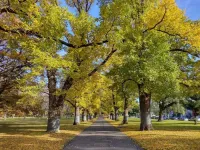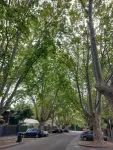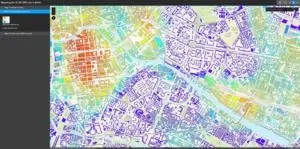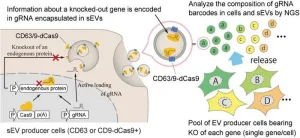(Press-News.org) A new study led by RMIT University in Australia measuring access to nature for eight major global cities found most still have inadequate canopy cover, despite access to an abundance of trees.
Less than 30% of buildings in New York City, Amsterdam, Buenos Aires, Denver, central Sydney and central Melbourne were in neighbourhoods with adequate canopy cover.
New York and Amsterdam both scored almost 0% for canopy cover despite 92% and 50% of buildings having views of at least three trees, respectively.
The research, a collaboration with the Technical University of Munich, studied over 2.5 million buildings across eight cities using an emerging sustainable cities measure, known as the ‘3-30-300' rule.
The rule states every house, school and workplace should have a view of at least three trees, be in a neighbourhood with at least 30% canopy cover, and be within 300 metres of a park.
Only Seattle and Singapore passed the 30% canopy benchmark, with 45% and 75% of buildings in these cities enjoying adequate shade, respectively.
Access to parks was also patchy, with Singapore and Amsterdam scoring high while Buenos Aires and New York City scored poorly.
Lead researcher and RMIT University research fellow, Dr Thami Croeser, said it was concerning that most of the buildings in the study failed the 30% tree canopy test.
With 2023 being the hottest year on record and 25% of the global population experiencing dangerous levels of extreme heat, canopy cover was urgently needed to cool down our cities, he said.
“Previous research has shown depression, anxiety, obesity and heatstroke are more prevalent in urban areas that lack access to shady tree canopy and green open spaces,” said Croeser, from RMIT’s Centre for Urban Research.
“Canopy cover doesn’t just increase cooling, it can also reduce flood risk as well as benefit mental and physical health and support urban biodiversity.
“Studies say we actually need at least 40% canopy cover to substantially lower daytime air temperatures, so the ‘30’ metric is the absolute bare minimum - and most buildings we studied don't even reach that goal.”
Croeser said current ways of designing or retrofitting streets did not support healthy canopy growth as planning prioritised infrastructure such as cabling and pipelines over tree growth.
“We need to stop thinking that allocated spaces for buildings and roads are permanent when they could be reallocated to prioritise green infrastructure,” he said.
“30% canopy cover seems like a high bar if we keep doing things the same way, but it’s totally achievable if we change a bit of our practice.
“Currently, we put trees last, and if it gets in the way of cabling or pipes, we remove the tree or replace it with a sapling.
"Designing trees into streets early, and then figuring out win-win solutions to get in utilities and traffic access, is one of the big changes we need to make a difference.”
Trees currently tend to be planted in conditions that were not easy for them to grow in, Croeser said.
“The soil is compacted, there’s asphalt over them and when it rains, the water runs off into the gutters instead of into the soil.”
“Earlier research shows that if urban trees are planted in better quality soil with enough space for them to grow, where rainwater can run directly into the soil, it will help trees grow bigger faster to address our lack of canopy cover.
"Trees in urban environments are also removed and replaced with saplings, or pruned very heavily, so not many trees get the opportunity to grow into big old canopy trees except in a few lucky areas.”
A new nature access metric with potential
While the ‘3-30-300' rule, devised by Dutch urban forestry expert Professor Cecil Konijnendijk, is still relatively new in Australia, it is gaining momentum internationally, with at least six cities in Europe, the US and Canada implementing the measure in their urban forestry strategies.
Konijnendijk said he devised the benchmark to help set a ‘bare minimum’ for nature in cities.
“Getting more parks and trees into cities is complicated work, and I realised that a simple metric could take the mystery out of it and set a proper benchmark based on evidence,” he said.
“I reviewed decades of science linking nature to human health – and found that views to nature, canopy cover and parks are all really essential if we want to be mentally healthy, physically active and safe from heatwave impacts.”
Professor Wolfgang Weisser, from the Technical University of Munich, said metrics that benchmark the adequacy of green infrastructure at a neighbourhood level in relation to human wellbeing were still rare.
“Some of the metrics we use now are not really sufficient whereas the ‘3-30-300' metric really demands that nature is brought to the areas that people actually live and work in,” Weisser said.
“A municipality with almost treeless streets and a few large, well-forested parks may score well on aggregated metrics of canopy and per-capita greenery but will be exposed as inadequate by the highly local ‘3’ and ‘30’ requirements.”
The researchers collaborated with Dutch firm Cobra Groeninzicht (Green Insights) to visualise the results.
“With the techniques our team has developed, we can calculate the ‘3-30-300’ benchmark for any city in the world,” said Dirk Voets, Senior Advisor Geospatial at Cobra Groeninzicht.
“Acute canopy deficits in global cities exposed by the 3-30-300 benchmark for urban nature”, with Thami Croeser, Roshan Sharma, Wolfgang Weisser and Sarah Bekessy, is published in Nature Communications. (DOI: 10.1038/s41467-024-53402-2))
END
Populations overheat as major cities fail canopy goals: new research
A new study led by RMIT University in Australia measuring access to nature for eight major global cities found most still have inadequate canopy cover, despite access to an abundance of trees.
2024-11-19
ELSE PRESS RELEASES FROM THIS DATE:
By exerting “crowd control” over mouse cells, scientists make progress towards engineering tissues
2024-11-19
Genes aren’t the sole driver instructing cells to build multicellular structures, tissues, and organs. In a new paper published in Nature Communications, USC Stem Cell scientist Leonardo Morsut and Caltech computational biologist Matt Thomson characterize the influence of another important developmental driver: cell density, or how loosely or tightly cells are packed into a given space. In both computational models and laboratory experiments, the team of scientists used cell density as an effective tool for controlling how mouse cells pattern themselves into complex structures.
“This paper represents progress towards our big picture goal of engineering synthetic ...
First American Gastroenterological Association living guideline for moderate-to-severe ulcerative colitis
2024-11-19
Bethesda, MD (Nov. 15, 2024) — The American Gastroenterological Association (AGA) has released a new clinical guideline on the pharmacological management of moderate-to-severe ulcerative colitis, published today in Gastroenterology. This guideline groups the 12 currently available advanced treatments based on efficacy, to simplify the decision-making process for gastroenterologists and the approximately 1.25 million patients in the U.S. living with ulcerative colitis.
“Since the first biologic ...
Labeling cell particles with barcodes
2024-11-19
Cell-to-cell communication through nanosized particles, working as messengers and carriers, can now be analyzed in a whole new way, thanks to a new method involving CRISPR gene-editing technology. The particles, known as small extracellular vesicles (sEVs), play an important role in the spread of disease and as potential drug carriers. The newly developed system, named CIBER, enables thousands of genes to be studied at once, by labeling sEVs with a kind of RNA “barcode.” With this, researchers hope to find what factors are involved in sEV release from ...
Groundwater pumping drives rapid sinking in California
2024-11-19
A new study shows land in California’s San Joaquin Valley has been sinking at record-breaking rates over the last two decades as groundwater extraction has outpaced natural recharge.
The researchers found that the average rate of sinking for the entire valley reached nearly an inch per year between 2006 and 2022.
Researchers and water managers have known that sinking, technically termed “subsidence,” was occurring over the past 20 years. But the true impact was not fully appreciated because the total subsidence had not been quantified. This was in part due to a gap in data. Satellite radar systems, which provide the most precise measure of elevation changes, ...
Neuroscientists discover how the brain slows anxious breathing
2024-11-19
LA JOLLA (November 19, 2024)—Deep breath in, slow breath out… Isn’t it odd that we can self-soothe by slowing down our breathing? Humans have long used slow breathing to regulate their emotions, and practices like yoga and mindfulness have even popularized formal techniques like box breathing. Still, there has been little scientific understanding of how the brain consciously controls our breathing and whether this actually has a direct effect on our anxiety and emotional state.
Neuroscientists ...
New ion speed record holds potential for faster battery charging, biosensing
2024-11-19
PULLMAN, Wash. – A speed record has been broken using nanoscience, which could lead to a host of new advances, including improved battery charging, biosensing, soft robotics and neuromorphic computing.
Scientists at Washington State University and Lawrence Berkeley National Laboratory have discovered a way to make ions move more than ten times faster in mixed organic ion-electronic conductors. These conductors combine the advantages of the ion signaling used by many biological systems, including the human body, with the electron signaling used by computers.
The new development, detailed in the journal ...
Haut.AI explores the potential of AI-enhanced fluorescence photography for non-invasive skin diagnostics
2024-11-19
Tallinn, Estonia – 19th November 2024, 10 AM CET – Haut.AI, a pioneering artificial intelligence (AI) company for skincare and beauty applications, has published an exciting scientific review—one that explores state-of-the-art developments in skin fluorescence photography and its applications, focusing on combining it with AI algorithms for non-invasive skin diagnostics. The study highlights the power of AI to enhance skin fluorescence photography, allowing early, non-invasive detection of skin conditions. This approach allows skincare experts to diagnose underlying issues ...
7-year study reveals plastic fragments from all over the globe are rising rapidly in the North Pacific Garbage Patch
2024-11-19
A study published today in IOP Publishing’s journal Environmental Research Letters reveals that centimetre-sized plastic fragments are increasing much faster than larger floating plastics in the North Pacific Garbage Patch [NPGP], threatening the local ecosystem and potentially the global carbon cycle.
The research, which draws from not-for-profit The Ocean Cleanup’s systematic surveys of the NPGP between 2015 and 2022, found an unexpected rise in mass concentration of plastic fragments that are ...
New theory reveals the shape of a single photon
2024-11-19
A new theory, that explains how light and matter interact at the quantum level has enabled researchers to define for the first time the precise shape of a single photon.
Research at the University of Birmingham, published in Physical Review Letters, explores the nature of photons (individual particles of light) in unprecedented detail to show how they are emitted by atoms or molecules and shaped by their environment.
The nature of this interaction leads to infinite possibilities for light to exist and propagate, or travel, through its surrounding environment. This limitless ...
We could soon use AI to detect brain tumors
2024-11-19
A new paper in Biology Methods and Protocols, published by Oxford University Press, shows that scientists can train artificial intelligence models to distinguish brain tumors from healthy tissue. AI models can already find brain tumors in MRI images almost as well as a human radiologist.
Researchers have made sustained progress in artificial intelligence (AI) for use in medicine. AI is particularly promising in radiology, where waiting for technicians to process medical images can delay patient treatment. Convolutional neural networks are powerful tools that allow researchers to train AI models on large image datasets to recognize ...
LAST 30 PRESS RELEASES:
For teens, any cannabis use may have impact on emotional health, academic performance
School meals could unlock major gains for human and planetary health
Menopause hormone therapy does not appear to impact dementia risk
Signature patterns of brain activity may help predict recovery from traumatic brain injury
Dresden study uncovers new key mechanism in cancer cells
New species are now being discovered faster than ever before, study suggests
Cannabis-based products show limited short-term benefit for chronic pain, with increased risk of adverse effects
Cannabis products with more THC slightly reduce pain but cause more side effects
Clearing the brain of aging cells could aid epilepsy and reduce seizures
Brain injuries linked with potential risk of suicide, new study finds
New technique lights up where drugs go in the body, cell by cell
New study finds movement of fishing fleets can reveal shifts in marine ecosystems
Embargoed: New evidence points to potential treatment for vascular dementia
Study uncovers disrupted brain balance in alcohol dependence
Working in groups can help Republicans and Democrats agree on controversial content moderation online
Structural findings reveal how distinct GPCR ligands create different levels of activation
Anything-goes “anyons” may be at the root of surprising quantum experiments
UC review: Maximizing workplace opportunity for veterans
From generation to complex control: Metasurfaces make perfect vortex beams "within reach"
Thin-film lithium niobate-based detector: recent advances and perspectives
Exploring why some people may tend to persistently make bad choices
How cells balance their protein levels
Nirsevimab vs RSVpreF vaccine for RSV–related hospitalization in newborns
Effectiveness and impact of maternal RSV immunization and nirsevimab on medically attended RSV in US children
AI gives scientists a boost, but at the cost of too many mediocre papers
Next-generation vision model maps tree growth at sub-meter precision
Genes aren’t destiny for inherited blindness, study shows
MIT study: High-fat diets make liver cells more likely to become cancerous
Exposure to multiple fine particulate matter components and incident depression in the US Medicare population
Risk of burdensome health care spending over time in the US
[Press-News.org] Populations overheat as major cities fail canopy goals: new researchA new study led by RMIT University in Australia measuring access to nature for eight major global cities found most still have inadequate canopy cover, despite access to an abundance of trees.









